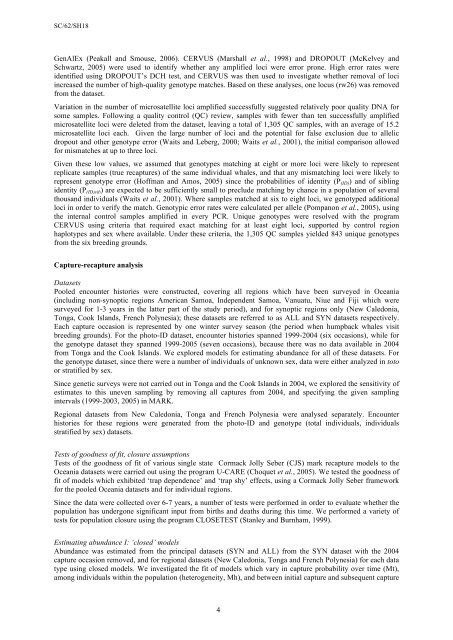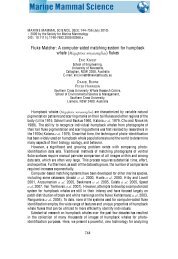Abundance and interchange of humpback whales in Oceania based ...
Abundance and interchange of humpback whales in Oceania based ...
Abundance and interchange of humpback whales in Oceania based ...
Create successful ePaper yourself
Turn your PDF publications into a flip-book with our unique Google optimized e-Paper software.
SC/62/SH18GenAlEx (Peakall <strong>and</strong> Smouse, 2006). CERVUS (Marshall et al., 1998) <strong>and</strong> DROPOUT (McKelvey <strong>and</strong>Schwartz, 2005) were used to identify whether any amplified loci were error prone. High error rates wereidentified us<strong>in</strong>g DROPOUT’s DCH test, <strong>and</strong> CERVUS was then used to <strong>in</strong>vestigate whether removal <strong>of</strong> loci<strong>in</strong>creased the number <strong>of</strong> high-quality genotype matches. Based on these analyses, one locus (rw26) was removedfrom the dataset.Variation <strong>in</strong> the number <strong>of</strong> microsatellite loci amplified successfully suggested relatively poor quality DNA forsome samples. Follow<strong>in</strong>g a quality control (QC) review, samples with fewer than ten successfully amplifiedmicrosatellite loci were deleted from the dataset, leav<strong>in</strong>g a total <strong>of</strong> 1,305 QC samples, with an average <strong>of</strong> 15.2microsatellite loci each. Given the large number <strong>of</strong> loci <strong>and</strong> the potential for false exclusion due to allelicdropout <strong>and</strong> other genotype error (Waits <strong>and</strong> Leberg, 2000; Waits et al., 2001), the <strong>in</strong>itial comparison allowedfor mismatches at up to three loci.Given these low values, we assumed that genotypes match<strong>in</strong>g at eight or more loci were likely to representreplicate samples (true recaptures) <strong>of</strong> the same <strong>in</strong>dividual <strong>whales</strong>, <strong>and</strong> that any mismatch<strong>in</strong>g loci were likely torepresent genotype error (H<strong>of</strong>fman <strong>and</strong> Amos, 2005) s<strong>in</strong>ce the probabilities <strong>of</strong> identity (P (ID) ) <strong>and</strong> <strong>of</strong> sibl<strong>in</strong>gidentity (P (ID)sib ) are expected to be sufficiently small to preclude match<strong>in</strong>g by chance <strong>in</strong> a population <strong>of</strong> severalthous<strong>and</strong> <strong>in</strong>dividuals (Waits et al., 2001). Where samples matched at six to eight loci, we genotyped additionalloci <strong>in</strong> order to verify the match. Genotypic error rates were calculated per allele (Pompanon et al., 2005), us<strong>in</strong>gthe <strong>in</strong>ternal control samples amplified <strong>in</strong> every PCR. Unique genotypes were resolved with the programCERVUS us<strong>in</strong>g criteria that required exact match<strong>in</strong>g for at least eight loci, supported by control regionhaplotypes <strong>and</strong> sex where available. Under these criteria, the 1,305 QC samples yielded 843 unique genotypesfrom the six breed<strong>in</strong>g grounds.Capture-recapture analysisDatasetsPooled encounter histories were constructed, cover<strong>in</strong>g all regions which have been surveyed <strong>in</strong> <strong>Oceania</strong>(<strong>in</strong>clud<strong>in</strong>g non-synoptic regions American Samoa, Independent Samoa, Vanuatu, Niue <strong>and</strong> Fiji which weresurveyed for 1-3 years <strong>in</strong> the latter part <strong>of</strong> the study period), <strong>and</strong> for synoptic regions only (New Caledonia,Tonga, Cook Isl<strong>and</strong>s, French Polynesia); these datasets are referred to as ALL <strong>and</strong> SYN datasets respectively.Each capture occasion is represented by one w<strong>in</strong>ter survey season (the period when <strong>humpback</strong> <strong>whales</strong> visitbreed<strong>in</strong>g grounds). For the photo-ID dataset, encounter histories spanned 1999-2004 (six occasions), while forthe genotype dataset they spanned 1999-2005 (seven occasions), because there was no data available <strong>in</strong> 2004from Tonga <strong>and</strong> the Cook Isl<strong>and</strong>s. We explored models for estimat<strong>in</strong>g abundance for all <strong>of</strong> these datasets. Forthe genotype dataset, s<strong>in</strong>ce there were a number <strong>of</strong> <strong>in</strong>dividuals <strong>of</strong> unknown sex, data were either analyzed <strong>in</strong> totoor stratified by sex.S<strong>in</strong>ce genetic surveys were not carried out <strong>in</strong> Tonga <strong>and</strong> the Cook Isl<strong>and</strong>s <strong>in</strong> 2004, we explored the sensitivity <strong>of</strong>estimates to this uneven sampl<strong>in</strong>g by remov<strong>in</strong>g all captures from 2004, <strong>and</strong> specify<strong>in</strong>g the given sampl<strong>in</strong>g<strong>in</strong>tervals (1999-2003, 2005) <strong>in</strong> MARK.Regional datasets from New Caledonia, Tonga <strong>and</strong> French Polynesia were analysed separately. Encounterhistories for these regions were generated from the photo-ID <strong>and</strong> genotype (total <strong>in</strong>dividuals, <strong>in</strong>dividualsstratified by sex) datasets.Tests <strong>of</strong> goodness <strong>of</strong> fit, closure assumptionsTests <strong>of</strong> the goodness <strong>of</strong> fit <strong>of</strong> various s<strong>in</strong>gle state Cormack Jolly Seber (CJS) mark recapture models to the<strong>Oceania</strong> datasets were carried out us<strong>in</strong>g the program U-CARE (Choquet et al., 2005). We tested the goodness <strong>of</strong>fit <strong>of</strong> models which exhibited ‘trap dependence’ <strong>and</strong> ‘trap shy’ effects, us<strong>in</strong>g a Cormack Jolly Seber frameworkfor the pooled <strong>Oceania</strong> datasets <strong>and</strong> for <strong>in</strong>dividual regions.S<strong>in</strong>ce the data were collected over 6-7 years, a number <strong>of</strong> tests were performed <strong>in</strong> order to evaluate whether thepopulation has undergone significant <strong>in</strong>put from births <strong>and</strong> deaths dur<strong>in</strong>g this time. We performed a variety <strong>of</strong>tests for population closure us<strong>in</strong>g the program CLOSETEST (Stanley <strong>and</strong> Burnham, 1999).Estimat<strong>in</strong>g abundance I: ‘closed’ models<strong>Abundance</strong> was estimated from the pr<strong>in</strong>cipal datasets (SYN <strong>and</strong> ALL) from the SYN dataset with the 2004capture occasion removed, <strong>and</strong> for regional datasets (New Caledonia, Tonga <strong>and</strong> French Polynesia) for each datatype us<strong>in</strong>g closed models. We <strong>in</strong>vestigated the fit <strong>of</strong> models which vary <strong>in</strong> capture probability over time (Mt),among <strong>in</strong>dividuals with<strong>in</strong> the population (heterogeneity, Mh), <strong>and</strong> between <strong>in</strong>itial capture <strong>and</strong> subsequent capture4



